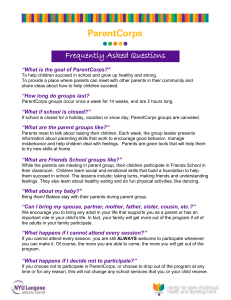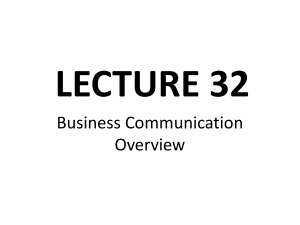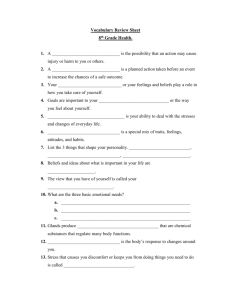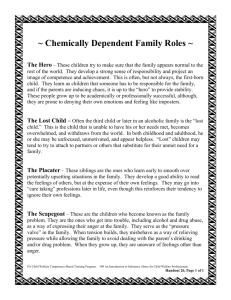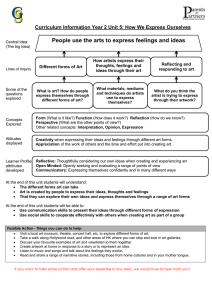I Can Statements: Behavior
advertisement
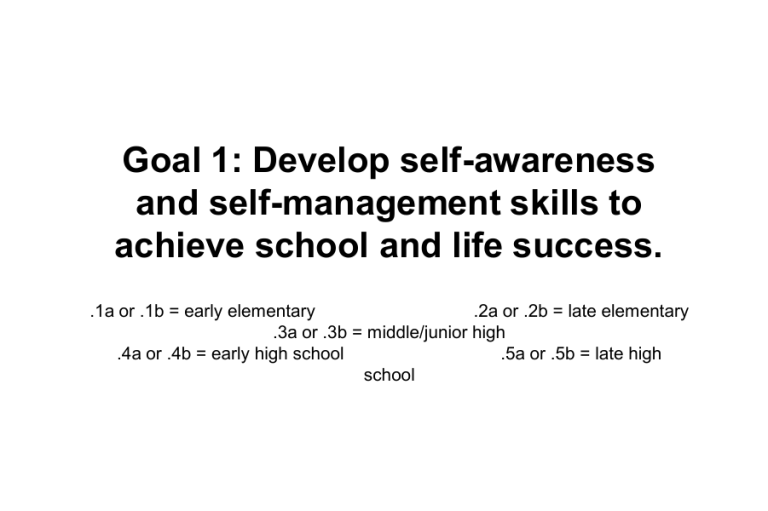
Goal 1: Develop self-awareness and self-management skills to achieve school and life success. .1a or .1b = early elementary .2a or .2b = late elementary .3a or .3b = middle/junior high .4a or .4b = early high school .5a or .5b = late high school Learning Standard 1A: Identify and manage one’s emotions and behavior I can recognize and name feelings. 1A.1a. I can tell how my feelings are linked to my behavior. 1A.1a. I can control my impulsive behavior. 1A.1b. I can tell about many feelings and talk about things that make me feel that way. 1A.2a. I can tell about and show ways to share my feelings with others in appropriate ways. 1A.2b. I can think and talk about things that make me feel stressed or motivate me to succeed. 1A.3a. I can cope with stress. 1A.3b. I can motivate myself to succeed. 1A.3b. I can analyze how thoughts and emotions affect decision-making and responsible behavior. 1A.4a. I can generate ways to develop more positive attitudes. 1A.4b. I can evaluate how expressing my emotions in different situations can affect others. 1A.5a. I can evaluate how expressing more positive attitudes can influence others. 1A.5b. Learning Standard 1B: Recognize personal qualities and external supports I can talk about what I like and don’t like. 1B.1a. I can talk about what I want and need. 1B.1a. I can talk about what I’m good at and what I need help with. 1B.1a. I can talk about good things about my family, friends, school, and neighborhood. 1B.1b. I can tell about some of my skills and interests that I want to get better at. 1B.2a. I can talk about how my family, friends, teachers, and others can help me with school. 1B.2b. I can talk about how my family, friends, teachers, and others can help me with my behavior. 1B.2b. I can think about how my personal traits influence my choices and successes. 1B.3a. I can think about how using school and community supports can help me succeed in school and life. 1B.3b. I can set priorities for building on my strengths and improving my weaknesses. 1B.4a. I can think about how positive adult role models and supports can help me succeed at school and in life. 1B.4b. I can implement a plan to build on a strength, meet a need, or address a challenge. 1B.5a. I can evaluate how developing my interests and helping others can help me succeed at school and in life. 1B.5b. Learning Standard 1C: Demonstrate skills related to achieving personal and academic goals I can talk about why school is important in helping me meet my goals. 1C.1a. I can talk about some goals I have for my grades and classroom behavior. 1C.1b. I can talk about how to set up and work toward a goal. 1C.2a. I can keep track of my progress toward meeting a short-term personal goal. 1C.2b. I can set a short-term goal and make a plan for meeting it. 1C.3a. I can talk about why I met or did not meet a goal. 1C.3b. I can identify strategies to use resources and overcome obstacles to meet my goals. 1C.4a. I can use strategies to overcome obstacles to meet my goals. 1C.4b. I can set up a post-secondary goal with action steps, timeframes, and criteria for evaluating success. 1C.5a. I can keep track of my goal progress and evaluate my performance against the criteria I determined. 1C.5b. Goal 2: Use social awareness and interpersonal skills to establish and maintain positive relationships. .1a or .1b = early elementary .2a or .2b = late elementary .3a or .3b = middle/junior high .4a or .4b = early high school .5a or .5b = late high school Learning Standard 2A: Recognize the feelings and perspectives of others I can show that I know other people may think or feel different than me. 2A.1a. I can use listening skills to figure out the feelings and thoughts of others. 2A.1b. I can figure out how other people may feel by watching what is happening and by seeing what they say or do. 2A.2a. I can talk about how other people think or feel. 2A.2b. I can predict other peoples’ thoughts and feelings in a variety of situations. 2A.3a. I can think about how my behavior may affect other people. 2A.3b. I can think about similarities and differences between my own and other peoples’ thoughts and feelings. 2A.4a. I can use conversation skills to understand other peoples’ thoughts and feelings. 2A.4b. I can show how to express understanding of those who think differently than me. 2A.5a. I can show ways to express empathy for others. 2A.5b. Learning Standard 2B: Recognize individual and group similarities and differences I can talk about how people are the same and how they are different. 2B.1a. I can say good things about other people. 2B.1b. I can describe how different groups of people can be different. 2B.2a. I can list good things about different groups of people. 2B.2a. I can show how to work well with people who are different than me. 2B.2b. I can explain how individual, social, and cultural differences may make people more likely to be bullied. 2B.3a. I can identify ways to prevent bullying. 2B.3a. I can discuss the effects of taking action against bullying that happens because someone is different. 2B.3b. I can analyze the cause and negative effects of stereotyping and prejudice. 2B.4a. I can show respect for individuals from different social and cultural groups. 2B.4b. I can evaluate strategies for being respectful of others and opposing stereotyping and prejudice. 2B.5a. I can evaluate how standing up for the rights of others can help everyone. 2B.5b. Learning Standard 2C: Use communication and social skills to interact effectively with others I can tell how to work and play well with others. 2C.1a. I can show how to get along with others. 2C.1b. I can show how to behave appropriately in the classroom. 2C.1b. I can talk about how to make and keep friends. 2C.2a. I can talk about how to work well in a group. 2C.2b. I can think about ways to form positive relationships with others. 2C.3a. I can cooperate and be a good team member to help my group succeed. 2C.3b. I can talk about the effects of asking for help from and giving help to others. 2C.4a. I can talk about my contribution in groups as a member and leader. 2C.4b. I can evaluate my communication and social skills in daily interactions with peers, teachers, and my family. 2C.5a. I can plan, implement, and evaluate my participation in a group project. 2C.5b. Goal 3: Demonstrate decisionmaking skills and responsible behaviors in personal, school, and community contexts. .1a or .1b = early elementary .2a or .2b = late elementary .3a or .3b = middle/junior high .4a or .4b = early high school .5a or .5b = late high school Learning Standard 3A: Consider ethical, safety, and societal factors in making decisions I can talk about why it is wrong to hurt other people. 3A.1a. I can talk about how right and wrong affects the way we act. 3A.1b. I can talk about how wanting to keep other people safe affects the way we act. 3A.1b. I can show how to respect myself and others. 3A.2a. I can show how right and wrong affects my thoughts and actions. 3A.2b. I can evaluate how honesty, respect, fairness, and compassion help me think about the needs of others when making choices. 3A.3a. I can talk about why we have laws and school rules. 3A.3b. I can show personal responsibility in making ethical decisions. 3A.4a. I can evaluate how social norms influence my decisions and actions. 3A.4b. I can evaluate how the expectations of authority figures influence my decisions and actions. 3A.4b. I can apply ethical reasoning to evaluate societal practices. 3A.5a. I can example how the norms of different societies and cultures influence their members’ decisions and behaviors. 3A.5b. Learning Standard 3A: Apply decision-making skills to deal responsibly with daily academic and social situations I can talk about many different choices that students make at school. 3B.1a. I can make positive choices when talking with or playing with classmates. 3B.1b. I can list the steps of making a decision. 3B.2a. I can make a decision following the steps I have learned. 3B.2b. I can think about different choices and consequences for things that happen at school and with friends. 3B.2b. I can talk about how decision-making skills improve my study habits and school success. 3B.3a. I can discuss strategies for resisting negative peer pressure to make unsafe or unhealthy choices. 3B.3b. I can evaluate my abilities to gather information, generate alternatives, and think about the consequences of my decisions. 3B.4a. I can apply decision-making skills to establish healthy friend and work relationships. 3B.4b. I can analyze how my current decisionmaking affects my college and career choices. 3B.5a. I can evaluate how responsible decisionmaking affects my relationships with others. 3B.5b. Learning Standard 3C: Contribute to the well being of one’s school and community I can talk about and show how to be helpful in my classroom. 3C.1a. I can talk about and show how to be helpful to my family. 3C.1b. I can talk about and show how to be helpful to my school. 3C.2a. I can talk about and show how to be helpful to my neighborhood. 3C.2b. I can evaluate how I helped to solve a problem or meet a need at school. 3C.3a. I can evaluate how I helped to solve a problem or meet a need in my neighborhood. 3C.3b. I can plan, implement, and evaluate how my actions as part of an activity or school organization have improved my school’s climate. 3C.4a. I can plan, implement, and evaluate how my actions as part of a group have improved my community. 3C.4b. I can work cooperatively with others to plan, implement, and evaluate a project to meet a need at school. 3C.5a. I can work cooperatively with others to plan, implement, and evaluate a project that addresses a need in the community. 3C.5b.
